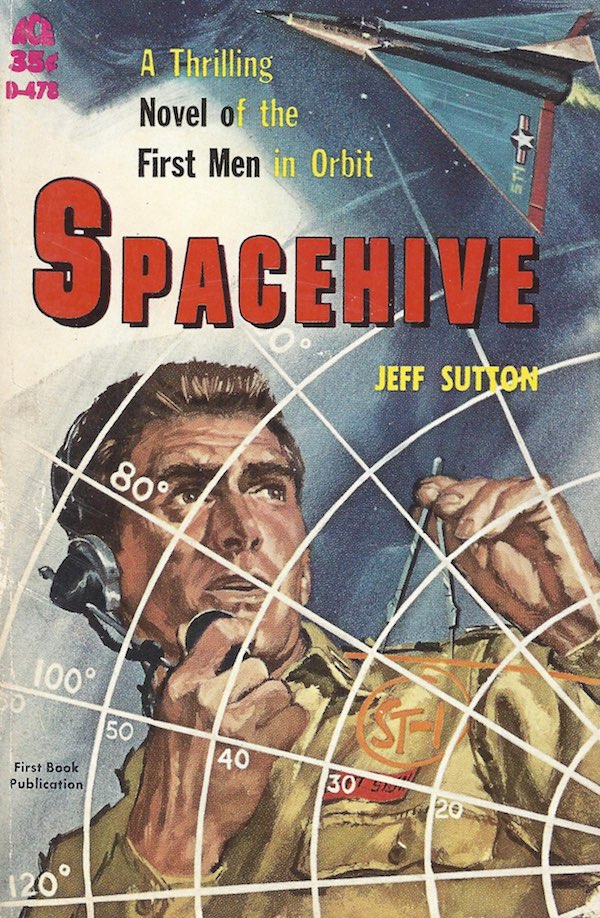Stories of cislunar suspense: Literary adventure on the near frontier (part 1)by Ken Murphy
|
| The near frontier of cislunar space occupies a strange place in science fiction literature. |
There’s a new phrase in the vernacular that you increasingly see in the popular media: cislunar space. This term refers to the space near Earth out to the Moon and its orbit, although all five of the Lagrange points of the Earth-Moon system are generally included despite the Earth-Moon L-2 point (EML-2) being technically translunar. The vast majority of our space assets can be found in this area, which can be roughly broken down as follows:
Low Earth Orbit (LEO): Earth observation, communications and data relay satellites, various small satellites, Hubble, ISS, and much more.
Medium Earth Orbit (MEO) and Highly Elliptical Orbit (HEO): more military-focused assets, like GPS and the things it’s best not to talk about.
Geostationary Earth Orbit (GEO): Mainly communications, data,and broadcast satellites for the distribution of information. Think DISH or Direct TV, or Sirius XM satellite radio. Plus pretty much all TV content gets distributed through this region.
EML-1: Crossroads of cislunar space, and strategic strong point, like the fort guarding the mountain pass. Untapped at this point, but with so much potential, as explored here (see “EML-1: the next logical destination”, The Space Review, January 24, 2011).
EML-2: Generally proposed as a site for assets providing communications with the Lunar farside (right above where we want to put our super-sensitive radio telescopes; I’d prefer a pole-sitting solar sail), and as a staging ground for translunar activities.
EML-3: generally considered the least desirable of the L-points (just look at the gravity/energy maps), it may yet prove useful.
EML-4 and EML-5: This is where the L-5 Society wanted to build large enclosed “island” habitats, better known as space colonies.
The Moon: Not just for lovers, the Moon is increasingly seen as a near-term resource solution until we can get our act together and start tapping the asteroids. Plus, it’s a great place to do some important science. And a potential tourist destination, and retirement home (I’ve fallen and I can’t… oh wait, I can get up!) Burgeoning with potential, the Moon is right there…
The near frontier of cislunar space occupies a strange place in science fiction literature. Most popular space sci-fi happens in operatic depictions of galaxy-wide empires and interactions with the super-physics and aliens that we speculate we will encounter “out there.” When it does restrict itself to the solar system, science fiction often heads for the dramatic locales like Mars, the Asteroid Belt, and Jupiter. The Moon no longer bears the veil of mystery of places untouched by human hands. This is also true of cislunar space. This isn’t necessarily a bad thing, as it allows cislunar space to be a locale in story genres beyond science fiction.
In this article, we’ll be looking at a variety of stories, from “Men’s Adventure Tales,” the realm of spies and paramilitary forces, and military men with advanced tactical systems, to medical thrillers, to even some romance, all with ties to the area of space encompassed by the Moon’s travels around Earth. While the bulk of the genre focuses on the usual array of bad guys—drug lords, terrorist masterminds, tinpot dictators, malevolent military minds, corporate sociopaths and the like whose psychopathy requires termination with extreme prejudice—there is the occasional foray into space, or at least some connection to orbital assets that drives the story. We’ll also be looking at traditional mysteries, where someone dies or something bad happens, usually by design, and the protagonist finds their life in danger as they unravel the machinations. In many ways, a space station provides the perfect “locked room” scenario for mystery writers. To help pad out the list there’s a dash of traditional sci-fi as well, though perhaps not all titles that one might expect.
I’ve left off a number of marginally relevant titles, such as Moonraker by Ian Fleming (about the development of a British ICBM, unlike the movie), Deception Point by Dan Brown (NASA plants a meteorite in the Arctic), Twisted Web by Tom Grace (NASA Antarctic researchers killed for what they found in the lake under the ice cap), The Switch by Sandra Brown (astronaut caught in a love triangle with twins, one of whom is murdered), and Outlanders: Devil in the Moon and Outlanders: Dragoneye by James Axler (ancient aliens Annunaki and Tuatha de Danaan battle on the Moon for control of humanity), as well as others.
| Spacehive includes one of the earliest mentions in fiction that I’ve seen of the phrase “cislunar space.” |
Also, since I purchase all of the books reviewed at local bookstores, there are many stories that I just haven’t been able to find a copy of to buy, like Luna: New Moon (rich people problems on the Moon) by Ian McDonald, or Countdown by Frank Slaughter. Readers are encouraged to offer suggestions in the comments, as I’m sure there are many works that I’ve just completely overlooked. While this overview tries to be comprehensive, with over 100 capsule reviews on tap, it should not be seen as definitive.
Enjoy your summer reading!
1950s
It’s the dawn of the Space Age. These pre-NASA stories have a much different feel to them than later books. Rocketry was advancing, as was the field of astronautics, leading to that fateful day on October 4, 1957 when the human story changed once again from the past to the future. Sputnik proved that we could not only touch space, but also stay there.
Satellite E One, Jeffery Castle (1954): After the turn of the millennium, humanity finally begins reaching out into space with the construction of Satellite Earth One (E One), as told from first person narratives. A very structured, British style to the text, which attempts to serve as an introduction to many astronautical concepts that would be facing those striving for space. The author got quite a bit right, but also a fair amount wrong. Of course, back then, no one really knew what this space thing was going to be all about... [GoodReads: 2.75/4]
Station in Space, James Gunn (1958): from a grand deception that first jumpstarts human space efforts, to the construction of the Doughnut and then the Big Wheel, and the psychoses of the first trips to Mars, this story covers the early years of cislunar development. Told through a series of first-person vignettes, it covers not only astronautics but also lies, politicking and murder. A bit stream-of-consciousness at times, this was probably my least favorite of the 1950s stories. [GoodReads: 3.89/9]
Skyport, Curt Siodmak (1959): the construction of a space hotel with a hospital wing for the well-to-do becomes a tool for corporate chicanery. Then disaster strikes, or is it sabotage? This one may end up as a movie. [GoodReads: 3.75/4]
Spacehive, Jeff Sutton (1960): It’s July, 1969, and the US has launched into orbit the components for an interplanetary spacecraft headed for Venus. But the Cold War runs hot in space and the Communist block is picking off US space assets, and the Space Hive, orbiting in a polar orbit along the day/night terminator, is in almost constant danger from attack. Includes one of the earliest mentions in fiction that I’ve seen of the phrase “cislunar space.” Definitely merits the GoodReads rating. [GoodReads: 4.50/2]
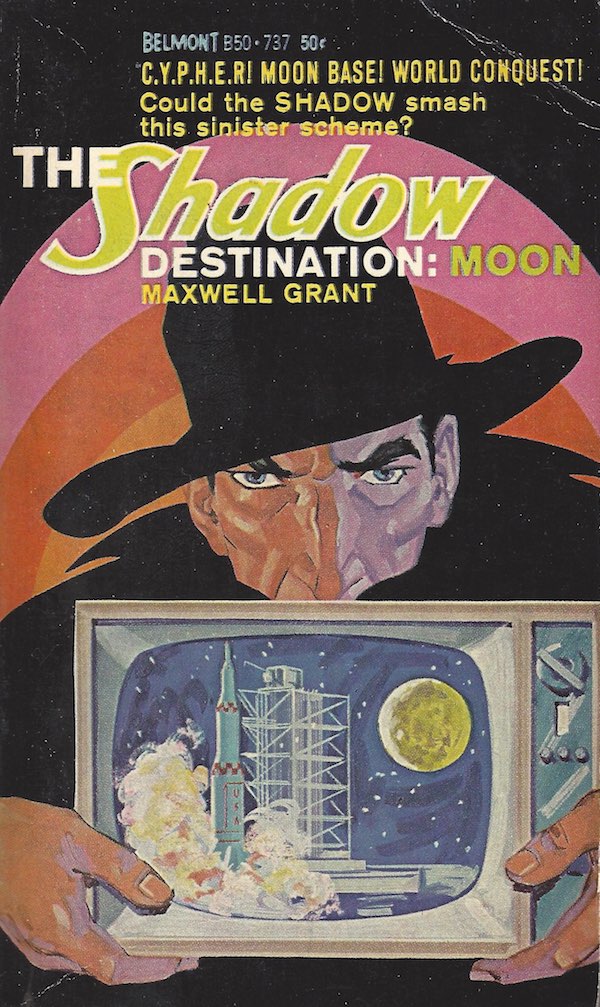 |
1960s
Ah, the 1960s, so innocent and naive compared to where we are now. The stories can still take delightful flights of fancy, and the rigors of astronautics need not be so rigorously applied. Lots of Moon stories (q.v. Bicentilune, infra) given the Apollo efforts, but the focus on orbital operations in the 50s was quickly moving outwards. Post-Apollo, the focus in space-themed literature quickly moved to the planets and the stars, leaving cislunar space behind.
In Like Flint, Bradford Street (1966): superspy Derek Flint uncovers a feminist plot to rule the world from an orbiting station in this adaptation of the movie. [GoodReads: 2.80/5]
The Man from U.N.C.L.E #8: The Monster Wheel Affair, David McDaniel (1967): A cargo ship sees something it should not have, and is destroyed. A huge space station appears in orbit, and neither the Soviets nor the Americans have any clue. It takes the super spies from U.N.C.L.E. to unmask a sinister plot that threatens the world. [GoodReads: 3.45/56]
The Shadow: Destination: Moon, Maxwell Grant (1967): a secret, parallel effort to reach the Moon is being sabotaged, but The Shadow knows the evil that lurks in the hearts of men. [GoodReads: N/A]
Nick Carter #32: Operation Moon Rocket (1968): The first crewed flight of the Saturn V rocket to test out the systems in Lunar orbit is sabotaged, and three astronauts die on the launch pad. It’s up to super-spy Nick Carter, the “Killmaster,” to uncover the Chinese plot and to ensure the safety of the next Moon launch. [GoodReads: 3.50/12]
Assignment… Star Stealers, Edward S. Aarons (1970): an unknown power has hijacked several advanced spy sats, and is selling the data to the highest bidders. Only super-spy Sam Durell can track down the malefactors and end their misdeeds. [GoodReads: 2.93/15]
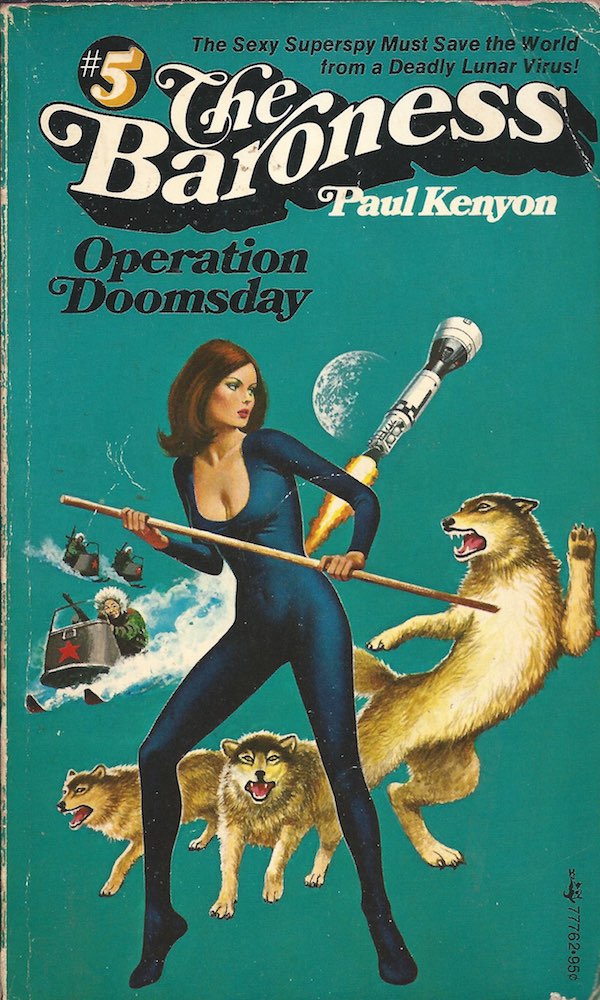 |
1970s
The bloom of Apollo faded in the 1970s, and there seems to have been some kind of societal angst about disaster, destruction, and the breakdown of the social order that manifested itself in the broader culture, but can be nevertheless found in the cislunar genre as well. This early psycho-social trauma for the Baby Boomer generation may still be shaping the society they are bequeathing to their successors. Gen X was just a bunch of cute (well-nigh feral by today’s standards) kids, generally oblivious to the larger contexts shaping the world. In space we laid our last (?) footprints on the Moon, put up Skylab, engaged in space détente with Apollo-Soyuz, and worked on the Space Shuttle to provide frequent and cheap access to space. My earliest real space recollections are of Dad ranting about the idiots letting Skylab fall out of the sky.
| Some in Island Grissom succumb to a form of claustrophobia called WAIDH (what am I doing here?) syndrome that seems to be contagious. Is it an unforeseen natural response to the Island environment, or something more sinister? |
City in the Sky, Curt Siodmak (1974): After the construction of the massive International Space City (ISC), a playground for the wealthy and connected, the former work shack is converted into a Space Prison for 60 of the world’s most dangerous misfits. New prisoner Bardou offers them a way out: spacejack the ISC to demand justice. The result is a feint/counter feint as each side vies for control. [GoodReads: 3.44/18]
Earthwreck, Thomas N. Scortia (1974): the crew of the Manned Orbital Station watches in horror as the nations of Earth erupt in a bloodbath of nuclear fire. Now their only hope is to team up with the crew of the Soviet station to ensure the survival of humanity. [GoodReads: 2.82/22]
The Baroness #5: Operation Doomsday, Paul Kenyon (1974): A Lunokhod mission returns samples from the Apollo 17 site. Turns out one of the astronauts had the flu. A radiation-mutated nano-machine-like virus from the Moon threatens to extinguish all life on Earth, and only super-spy Baroness Penelope St. John Orsini (and a well-placed nuke) can save the day. [GoodReads: 4.00/11]
Satellite City, Mack Reynolds (1975): In the 21st century, what started as an evolution of Skylab has evolved into Satellite City - playground of the rich, hospital of amazing cures, and laboratory for the most advanced science. For a price. Private investigator Rex Bader is sent to investigate whether “anything?…” can be procured for a price there, and unveils a conspiracy centuries old. A bit of deus ex machina in the psionics, and the editing was atrocious in my paperback copy. [GoodReads: 3.50/28]
Skyfall, Harry Harrison (1976): a huge nuclear-powered vehicle carrying the seeds of a Solar Power Satellite system is trapped in LEO with an ever-decreasing perigee, threatening to bring it down on the greater Los Angeles metropolitan area. A desperate race against an incoming solar flare and orbital mechanics ensues. [GoodReads: 3.36/172]
Lucifer’s Hammer, Larry Niven & Jerry Pournelle (1977): while the space station crew watches, a comet grazes the Earth and basically wipes out civilization. It’s the end of the world as we know it, but what will life be like afterwards? [GoodReads: 3.98/32,601]
Death Merchant #27: The Surinam Affair, Joseph Rosenberger (1978): the NSA’s new spy satellite is hijacked by unknown forces and begins photographing the US. When the capsule lands in Surinam, it’s up to Richard Camellion, the Death Merchant, to make sure it doesn’t fall into the wrong hands. [GoodReads: 3.00/2]
The Fountains of Paradise, Arthur C. Clarke (1978): In the 22nd century, engineer extraordinaire Vannevar Morgan applies his bridge-building skills to building a bridge to space. Less technically focused than the more recent Pillar to the Sky, Fountains of Paradise is focused on a series of dramatic events that occur during the building of the space elevator. Reading it in English seemed less impressive than my first read-through in French while at ISU. [GoodReads: 3.95/19,415]
Lagrange Five, Mack Reynolds (1979): it takes an IQ of 130+ and superb physical health to become an Island colonist. Nevertheless, some in Island Grissom succumb to a form of claustrophobia called WAIDH (what am I doing here?) syndrome that seems to be contagious. Is it an unforeseen natural response to the Island environment, or something more sinister? Oh, and there are unscrupulous folks who want to take over and control the Island (hmm...cui bono?) Only private detective Rex Bader can expose the culprits. [GoodReads: 3.15/39]
The Right Stuff, Tom Wolfe (1979): A fictionalized history of the earliest days of space exploration, when men were Men, women were Women, and small furry animals were scared. Almost universally regarded, together with the movie adaptation, as a classic. [GoodReads: 4.23/30,583]
Who’s on First?, William F. Buckley, Jr. (1980): Hungarian freedom fighters and Russian rocket scientists find their lives intertwined in CIA agent Blackford Oakes, who seeks to slow Russian efforts to get the first satellite in orbit. [GoodReads: 3.71/303]
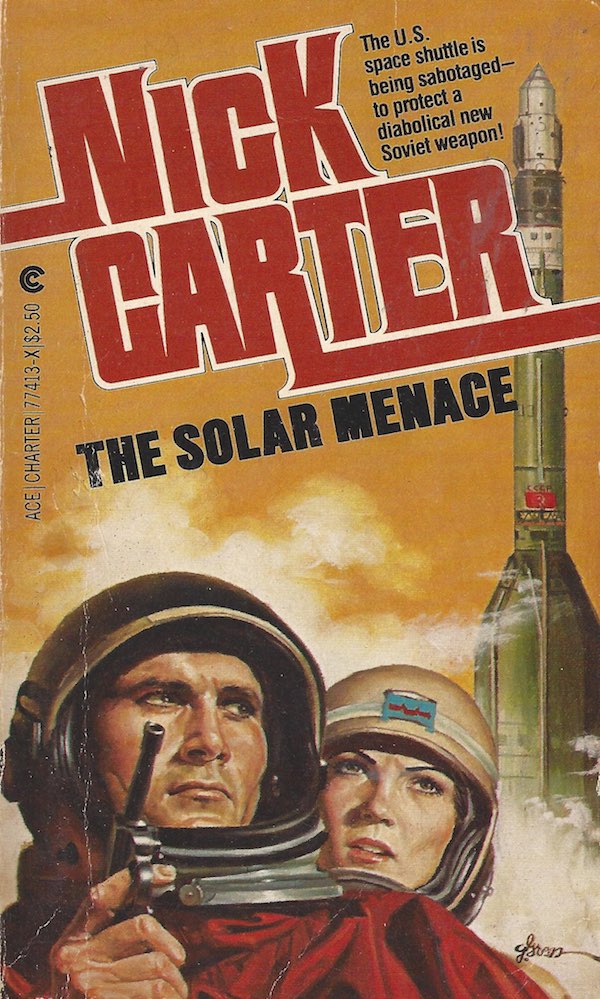 |
1980s
Ah, the 1980s, what a decade. The Baby Boomers were starting to settle down (Baby on Board signs proliferated as the Millennials first entered the picture) and move into positions of authority. Gen X was just beginning to feel the first flush of adulthood. There was a cultural flowering that embraced a much greater diversity than in generations past. But as the decade progressed the social zeitgeist shifted, and the message became clear: “Let the looting commence.” It is, after all, easier to ask for forgiveness than permission. Cocaine is a helluva drug. The Cold War waxed (Star Wars/SDI) and then waned, and the MIC began looking for new threats that needed expensive weapon systems. Challenger scarred a generation into pursing cyberspace, not outer space, and the Russians put up Mir.
Death Beam, Robert Moss (1981): Soviet spymasters concoct a complex web of espionage to enable the Soviets to secretly launch an energy beam payload to space, one that can “neutron bomb” entire cities from orbit and give the Soviets the high ground in the Cold War. [GoodReads: 2.74/39]
Death Merchant #47: Operation Skyhook, Joseph Rosenberger (1981): when the Soviets launch a test laser satellite, the US hijacks it to crash it into the ocean. When it instead lands in Indonesia, it’s up to the Death Merchant to secure it before the Soviets do. [GoodReads: 2.50/2]
Nick Carter - Killmaster #150: The Solar Menace, Conde Nast Publications (1981): the Soviets have developed a death beam and are using it to target strategic assets, including the shuttle Columbia. Only super-agent Nick Carter can thwart the threat to world peace. [GoodReads: 3.00/4]
Orbit, Thomas H. Block (1982): during a routine suborbital hop, the Star Streak’s engines are somehow throttled up to full, stranding it in orbit with over 100 souls on board. It’s a race against time as oxygen starts running out. Some wonky physics in this one. [GoodReads: 3.35/46]
Space, James Michener (1982): Starting in the late ’40s, and continuing into the 1970s, this fictionalized history tome is the story of four men whose fates are entwined in an Apollo 18 mission to the far side of the Moon. [GoodReads: 3.93/4,302]
The Taking of Satcon Station, Barney Cohen & Jim Baen (1982): Fleet Agent Bockhorn gets a missing persons case on Satcon Station, a past-its-prime orbital manufacturing facility. The case becomes a noir mystery as his investigation threatens nefarious intentions. [GoodReads: 3.00/6]
| A space colony in GEO must deal with a mafia gun moll on the run, the Church of Elvis, and various other crises, leading to a declaration of independence. |
The Lagrangists, Mack Reynolds (1983): as the first of several planned orbital colonies, there are many who would see the efforts on Island One quashed. Private dick Rex Bader is hired to protect the project manager and unveil the devilish plots to control the future. [GoodReads: 3.33/3]
Chaos in Lagrangia, Mack Reynolds (1984): groups are building Islands out in the asteroid belt, and of course a group of armed thugs takes over the anarchists’ Island. The arms are traced back to the Island Three Grissom, where forces are conspiring to defeat the construction of a larger Island Four. Can Rex Bader again save Professor Casey from those who would control humanity’s future in space? [GoodReads: 3.44/16]
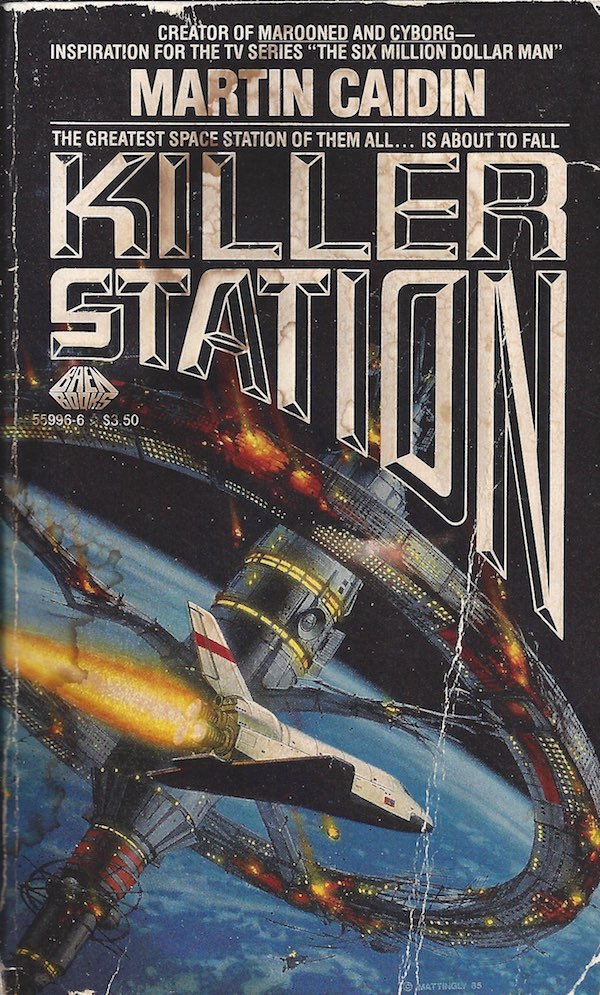 |
Killer Station, Martin Caidin (1984): a large space station under construction in orbit is sabotaged, threatening to bring it down on the greater New York metropolitan area. A desperate race against an incoming solar flare and orbital mechanics ensues. Reads a bit like the adaptation of a movie. [GoodReads: 3.29/21]
Privateers, Ben Bova (1985): the Soviets have seized control of space from the US, and control orbital operations out to the Moon and its mines. A number of facilities maintain their independence, but the Soviets are moving to consolidate control and cement communist rule of the space future. Only exiled American Dan Randolph can save the day by breaking all the rules. [GoodReads: 3.56/485]
The Destroyer #63: The Sky is Falling, Warren Murphy & Richard Sapir (1985): the development of a Solar Power Sat could make Chemical Concepts a leader in energy provision to the world, but a ruthless corporate officer has other plans. Only the masters of Shinanju can save the world from being burned to a crisp. [GoodReads: 3.72/101]
Track #8: Revenge of the Master, Jerry Ahern (1985): the malefactors of D.E.A.T.H. have planted a bomb on the space shuttle, and only super-adventurer Track can save the day. [GoodReads: 3.82/11]
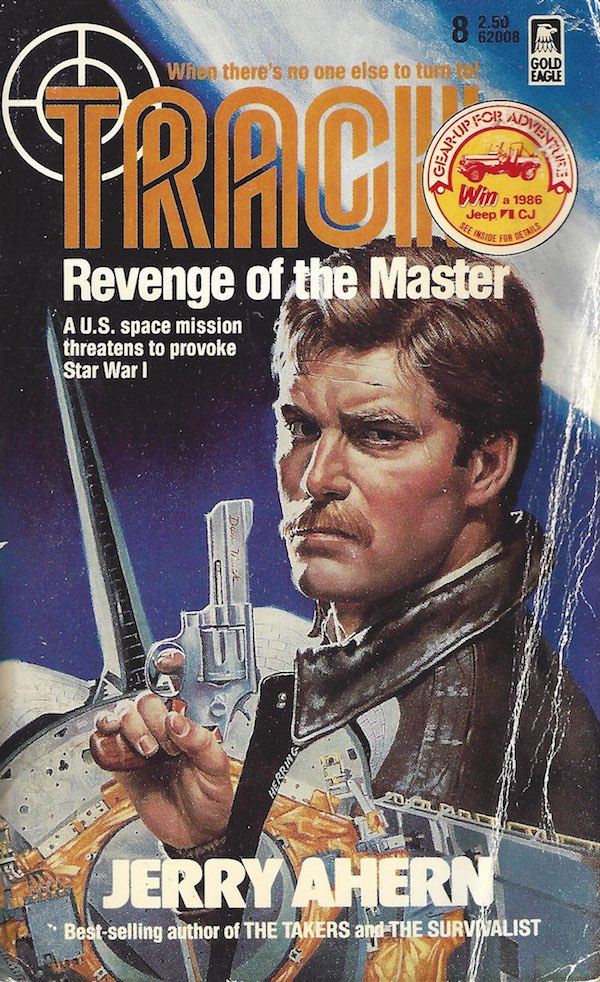 |
Trojan Orbit, Mack Reynolds & Dean Ing (1985): the last of Mack Reynold’s L-5 series, this one is set in the earliest years of the construction of Island One. The building of Island One has stalled out, but billions keep getting spent. Is it a fruitless project, or is there something else going on? [GoodReads: 3.09/11]
M*E*D*U*S*A, Janet & Chris Morris (1986): the Soviets and Americans play a dangerous game of chicken to probe each other’s defenses, putting Skylab 2 at risk, necessitating an orbital rescue by the advanced trans-atmospheric vehicle MEDUSA. [GoodReads: 3.40/10]
Nick Carter - Killmaster #217: Death Orbit, Conde Nast Publications (1986): an astronaut is killed on orbit during deployment of SDI sats, and it’s up to super-spy Nick Carter to uncover a conspiracy reaching into the highest levels of NASA, leading to a showdown in space. [GoodReads: 4.00/1]
Deadly Force #2: Special Delivery, Mark Dixon (1987): a Soviet launch gone bad of a laser satellite leads to a race to recover the remains in the wilds of North Canada. [GoodReads: 3.67/3]
Red Centre, Frederick Nolan (1987): Soviet spymasters concoct a complex web of espionage to enable the Soviets to secretly launch a top secret payload to orbit, one that can give the Soviets the high ground in the Cold War, leading to a desperate game of Spy vs. Spy in south Florida. [GoodReads: 0.00/0]
Doomsday Warrior #14: American Death Orbit, Ryder Stacy (1988): at the end of the 21st century, 100 years after the big nuke war turned the world into a barren wasteland of mutants and death, Ted Rockson, the Doomsday Warrior, leads the citizenry of Century City into a safer future. When the ultimate of evils, Space Nazis, begin harvesting the old SDI and Soviet equivalent space hardware and assembling a giant space wheel, it’s up to D.W. to take them out. [GoodReads: 3.62/16]
Endgame Enigma, James P. Hogan (1988): the Soviets have constructed a massive torus station at EML-1, named Valentina Tereshkova, and spies in Washington are convinced it’s a weapons platform despite all evidence to the contrary. An espionage mission goes wrong, but ultimately reveals the startling truth about the station. [GoodReads: 3.42/257]
Silver Tower, Dale Brown (1988): as the world teeters on the edge of open war, the US races to complete an orbital laser defense system on their space station, the Silver Tower. Can it survive an attack from the bad guys? [GoodReads: 3.88/1,321]
Able Team #43: Kill Orbit, Dick Stivers (1989):The race to return the shuttle to orbit has led to a refit of the Enterprise and its imminent launch from Vandenberg, but a turncoat in the military enables a Soviet plot to blow it out of the sky. Able Team scrambles to confound the malefactors. [GoodReads: 3.33/12]
Night Launch, Sen. Jake Garn & Stephen Cohen (1989): a terrorist hijacks the Shuttle Discovery, but the enemy is not one of the usual suspects. [GoodReads: 3.43/7]
Orbital Decay, Allen Steele (1989): blue-collar workers at Olympus Station building solar power satellites, a contraband cannabis crop in the hydroponics module, and an NSA plot to snoop on US citizens (in the name of security!) all lead to a treasonous plot. Or is it patriotic? [GoodReads: 3.73/410]
Storming Intrepid, Payne Harrison (1989): the Soviets use a deep-plant secret agent to hijack the Shuttle Intrepid carrying a secret defense payload. Complications arise. [GoodReads: 3.86/452]
Clarke County, Space, Allen Steele (1990): a space colony in GEO must deal with a mafia gun moll on the run, the Church of Elvis, and various other crises, leading to a declaration of independence. [GoodReads: 3.71/237]
Lifeline, Kevin J. Anderson & Doug Beason (1990): the crew watches in horror as the nations of Earth erupt in a bloodbath of nuclear fire. Stations at the Lagrange points and at Clavius Base on the Moon must struggle to survive, each taking a different route into how they address the crisis. A new way at looking at a RIF, that’s for sure. [GoodReads: 3.59/107]
The Guardians #14: Death from Above, Richard Austin (1990): In a post-World War III America, the Guardians are tasked with pulling together the pieces of the Blueprint for Renewal. When someone hijacks the Cygnus space station and puts its lasers to use against targets on Earth, it’s up to the Guardians to hijack it back. [GoodReads: 4.25/16]
War God, Patrick F. Rogers (1990): a powerful and advanced military WarSat crashes on a remote island in the Pacific and the race is on to recover the high tech goods. [GoodReads: 3.75/4]
Next week: The 1990s and the 21st century.
